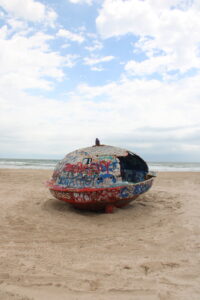
By CATHERINE DONNELLY
Special to the PRESS
Sometime in SPI’s not too distant past, a plain orange ‘UFO’ washed up on the shore of South Padre Island (SPI) between mile markers #9 and #10. It was approximately 2004, when the band OutKast was climbing the charts with their song “Hey Ya!” and “George Dubya” was in the middle of his 2-term presidency.
What was affectionately nicknamed the ‘UFO’ is actually an escape pod vessel or lifeboat pod from an oil rig platform in the Gulf, according to local resident Tommy Saenz, aka “Tiki Tommy.” A quick Google search shows that they come in a variety of sizes, shapes and capacities. SPI’s UFO is a smaller pod that’s 14 feet in diameter and resembles the spaceship from “Lost in Space” and countless other Science Fiction shows and movies. It’s very apparent how it earned its name. Larger craft, on the other hand, usually resemble the “Yellow Submarine” of Beatles fame.
According to Tiki Tommy, this watercraft are made of fiberglass and come with bench seating, seatbelts, an engine for propulsion, a rudder to steer with, a rudimentary bathroom, a beacon location signal, and would generally have other provisions like life vests, food and water in case an event has necessitated a quick escape from the ship or oil rig platform. Importantly, while these enclosed lifeboats resemble a submarine, they travel along the surface and are self-righting in case they capsize.
Many used or expired pods in various condition can be found on the open market as they’re being disposed of from giant ships that are being scrapped, ready to have a renewed purpose that is only limited by the next owner’s imagination. Occasionally, as in the case of SPI’s UFO, it simply escapes a rig platform or ship and just washes up on shore like the countless other things the sea continually gifts to the land.
SPI’s UFO has had an interesting life of decay as it’s pillaged by visitors and exposed to the elements over time, but has simultaneously started a new phase as a constantly developing piece of environmental art. At some point, it was also moved from its original location and dragged to its current location somewhere near mile marker #6. Surely someone out there knows when and why.
Shortly after the UFO ‘landed,’ it was discovered by Doug Wicks, an environmental artist and winter Texan from Montana, said Tiki Tommy. He would come down every year for three to four months at a time and clean up the beaches, then make art installations with the mostly plastic trash that he would find. He was also a self-avowed nudist and would generally work on the UFO and other installations in the buff unless there was a lady present. “No tan lines” was his motto.
Saenz and others teamed up with Wicks and worked on their masterpiece. They painted it and glued seashells, crushed aluminum cans, and different kinds of other beach debris all over it until it was a sublime work of art. When they weren’t working on it, others also added paint or writing or whimsical toys and other items to the vessel, inside and out. Each visit to the UFO would be a different iteration of its layers of ever-evolving art.
Wicks looked forward to working on his various art installations each year, including the UFO which had taken on a life of its own. One of his other works is a tower of upended plastic buckets of different colors, crowned with a hard hat and surrounded by the bucket’s colorful lids half-buried into the sand.
The pink item is a plastic piece that is dragged along during surveying and is now adorned with cigarette lighters and various other detritus. He would frequently attach flags, rope, plastic bottle caps, toys, lighters and other colorful curios to logs and pieces of driftwood. He once made a representation of a tree in wood and the leaves were found flip flops with little flowers made of lighters crawling up the “trunk.” Sadly, Wicks has since passed away.
As someone gets close to the UFO, the sand dips downward toward the bottom of the vessel. In the warmer months, it’s a haven for rattlesnakes and people have been bitten by them.
“It’s important to warn people about the rattlesnakes around the bottom of the UFO,” said Saenz. “People like to get up close to it and even add to it, but it could put them in danger if they’re not careful.”
One of the original things painted on the UFO was “Nude Beach” with an arrow pointing towards the northern tip of SPI. People frequently ask if there really is a nude beach that way, and if so, where is it?
“Well, if you drive up the beach from Access #6 and go to where the end of the road is, if you go about 5 miles past that, you’ll find the nude beach,” said local historian Steve Hathcock. “There’s a whole lot of nothing past there, so we would tell people that if they’re far enough out that they feel comfortable taking their clothes off, then that’s where the nude beach is.”
According to Saenz, there used to be a sign that simply has the word “Nude” scrawled on it in black paint, and that’s apparently where the nude beach is.
“You can find people nude bathing in that general area, but there is a hand-painted sign that tells you where the nude beach is actually located,” said Saenz.
So, the curious are on their own when trying to find the unofficial nude beach on SPI. Of note, it is illegal to drive on any of the city beaches which can garner fines of up to $500. It is illegal to drive over the sand dunes, as they are protected. Vehicles can only use county accesses to get onto the beaches. It’s important to check the weather and tide charts before embarking down the shoreline. The speed limit is 15 mph on the Texas beaches that allow vehicles.
According to the sopadre.com website, SPI beaches allow camping from County Access #5 to any point north of that. There is a nominal fee to access the county beach by vehicle and the first several miles are accessible by most two-wheel drive vehicles and RVs. From that point on, the beach is probably only accessible to four-wheel drive vehicles.
Also, there are no amenities and cell service is spotty. The good news is that bonfires, pets, and fishing are allowed. There are showers and restrooms at Beach Access #5 and a large dumpster to empty trash as leaving no trace of one’s visit is the courteous and ecologically conscious thing to do. For general questions about visiting South Padre Island, contact the island’s Visitors Center at info@sopadre.com or call (956) 761-6433.
News Source: portisabelsouthpadre.com



Leave a Reply